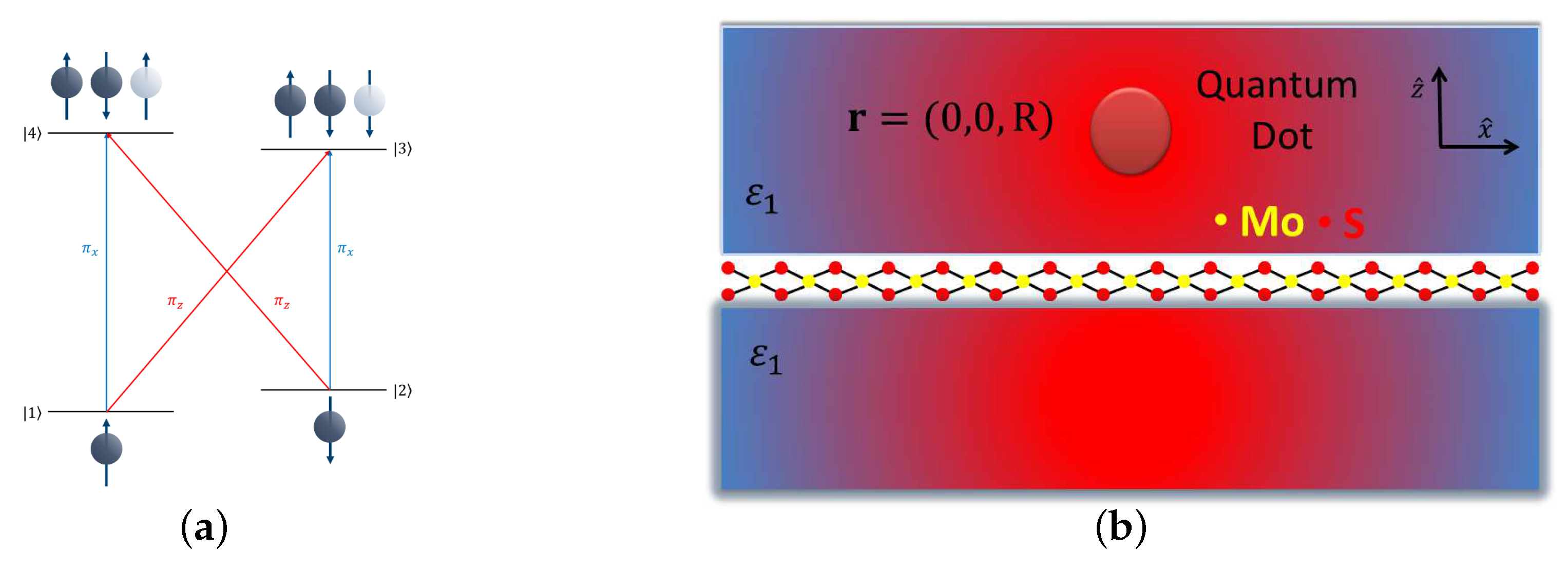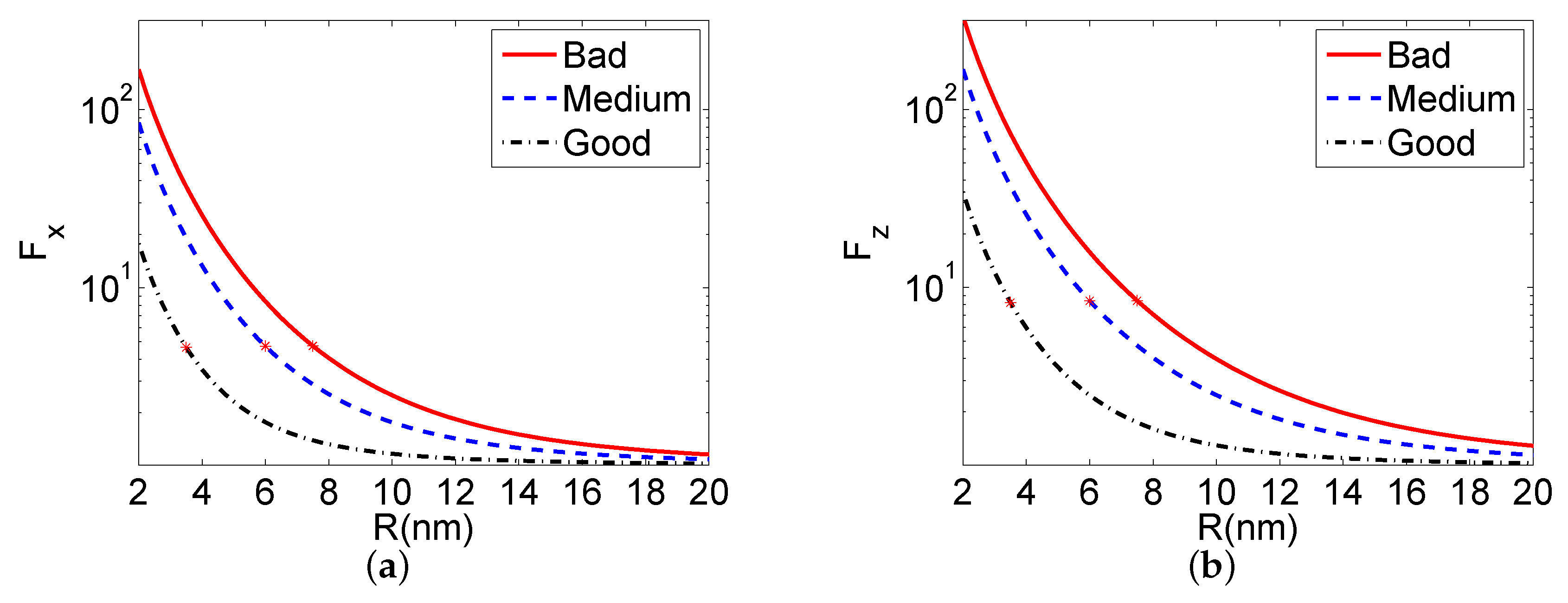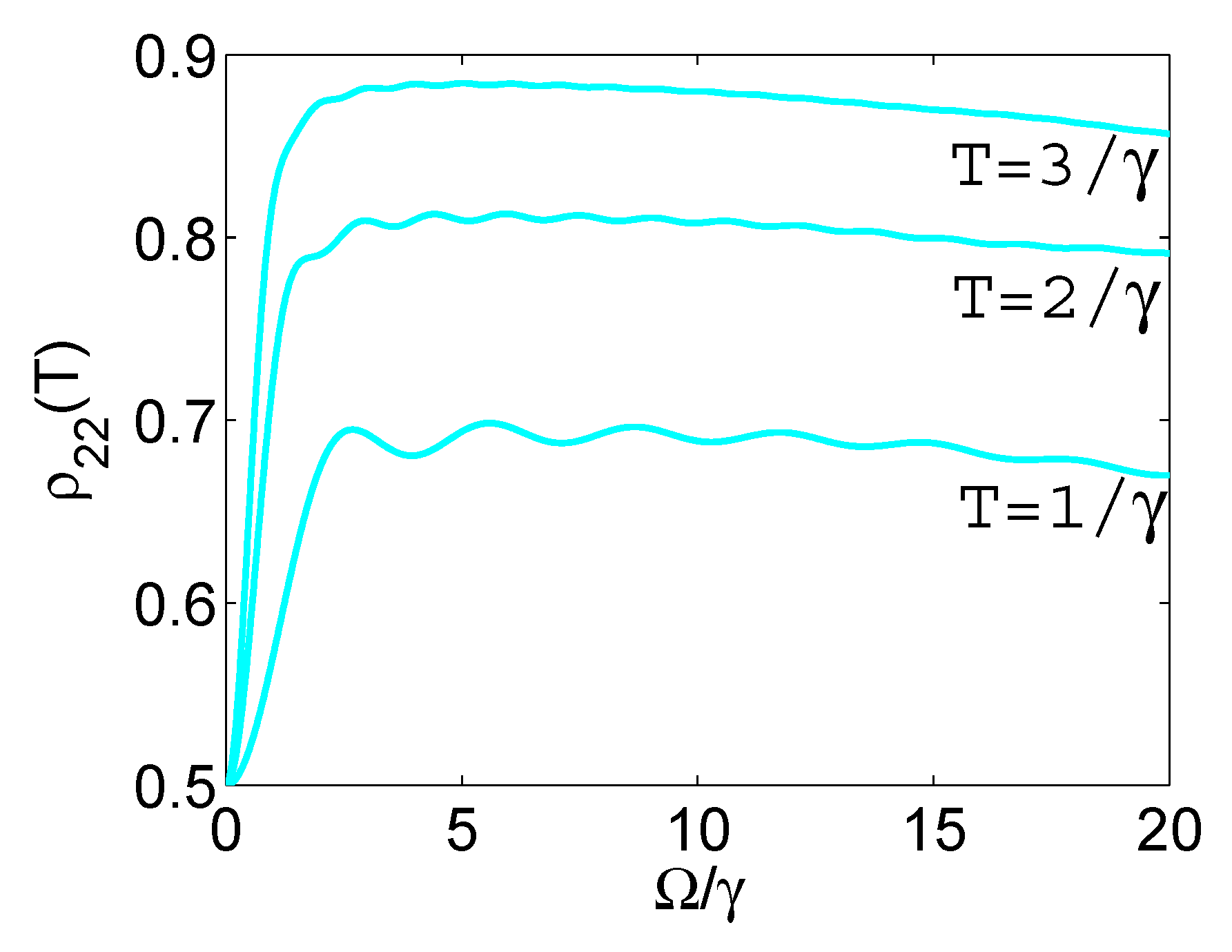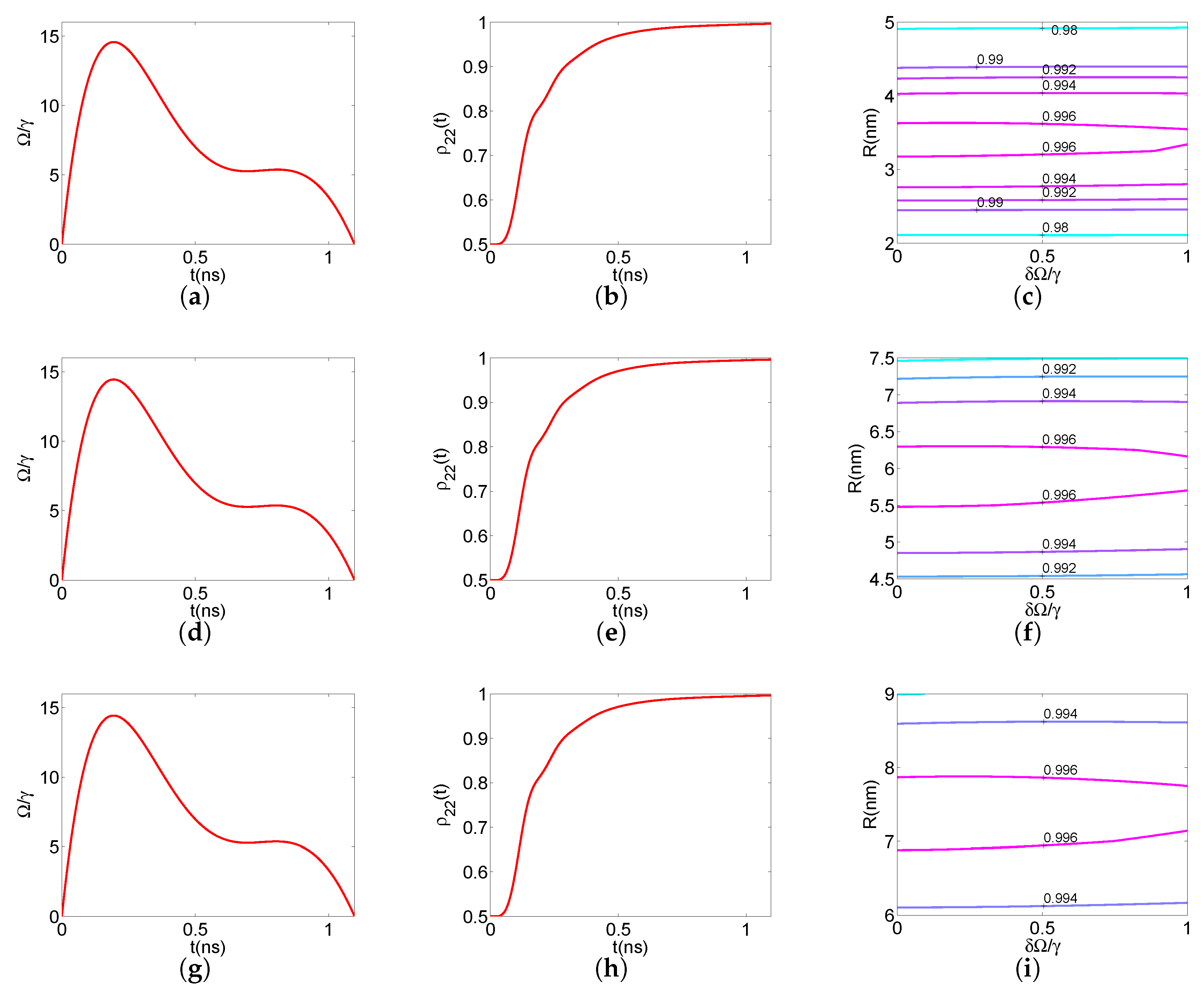Rapid Optical Spin Initialization of a Quantum Dot in the Voigt Geometry Coupled to a Two-Dimensional Semiconductor
Abstract
1. Introduction
2. Density Matrix Equations for the QD Near a MoS Monolayer under Interaction with an Optical Field
3. Rapid Spin Initialization with Optical Fields
3.1. Constant Control
3.2. Time-Dependent Control
4. Conclusions
Author Contributions
Funding
Conflicts of Interest
Abbreviations
| QD | Quantum dot |
References
- Michler, P. (Ed.) Quantum Dots for Quantum Information Technologies; Springer: Berlin/Heidelberg, Germany, 2017. [Google Scholar]
- Warburton, R.J. Single spins in self-assembled quantum dots. Nat. Mater. 2013, 12, 483–493. [Google Scholar] [CrossRef] [PubMed]
- Gao, W.B.; Imamoglu, A.; Bernien, H.; Hanson, R. Coherent manipulation, measurement and entanglement of individual solid-state spins using optical fields. Nat. Photonics 2015, 9, 363–373. [Google Scholar] [CrossRef]
- Xu, X.; Wu, Y.; Sun, B.; Huang, Q.; Cheng, J.; Steel, D.G.; Bracker, A.S.; Gammon, D.; Emary, C.; Sham, L.J. Fast spin state initialization in a singly charged InAs-GaAs quantum dot by optical cooling. Phys. Rev. Lett. 2007, 99, 097401. [Google Scholar] [CrossRef] [PubMed]
- Press, D.; Ladd, T.D.; Zhang, B.; Yamamoto, Y. Complete quantum control of a single quantum dot spin using ultrafast optical pulses. Nature 2008, 456, 218–221. [Google Scholar] [CrossRef] [PubMed]
- Delteil, A.; Sun, Z.; Gao, W.-B.; Togan, E.; Faelt, S.; Imamoglu, A. Generation of heralded entanglement between distant hole spins. Nat. Phys. 2016, 12, 218–223. [Google Scholar] [CrossRef]
- Lagoudakis, K.G.; McMahon, P.L.; Fischer, K.A.; Puri, S.; Müller, K.; Dalacu, D.; Poole, P.J.; Reimer, M.E.; Zwiller, V.; Yamamoto, Y.; et al. Initialization of a spin qubit in a site-controlled nanowire quantum dot. New J. Phys. 2016, 18, 053024. [Google Scholar] [CrossRef]
- Sun, S.; Kim, H.; Luo, Z.; Solomon, G.S.; Waks, E. A single-photon switch and transistor enabled by a solid-state quantum memory. Science 2018, 361, 57–60. [Google Scholar] [CrossRef]
- Economou, S.E.; Sham, L.J.; Wu, Y.; Steel, D.G. Proposal for optical U(1) rotations of electron spin trapped in a quantum dot. Phys. Rev. B 2006, 74, 205415. [Google Scholar] [CrossRef]
- Emary, C.; Xu, X.; Steel, D.G.; Saikin, S.; Sham, L.J. Fast initialization of the spin state of an electron in a quantum dot in the Voigt configuration. Phys. Rev. Lett. 2007, 98, 047401. [Google Scholar] [CrossRef]
- Economou, S.E.; Reinecke, T.L. Theory of fast optical spin rotation in a quantum dot based on geometric phases and trapped states. Phys. Rev. Lett. 2007, 99, 217401. [Google Scholar] [CrossRef]
- Emary, C.; Sham, L.J. Optically controlled single-qubit rotations in self-assembled InAs quantum dots. J. Phys. Condens. Matter 2007, 19, 056203. [Google Scholar] [CrossRef][Green Version]
- Sun, H.; Feng, X.-L.; Wu, C.; Liu, J.-M.; Gong, S.-Q.; Oh, C.H. Optical rotation of heavy hole spins by non-Abelian geometrical means. Phys. Rev. B 2009, 80, 235404. [Google Scholar] [CrossRef]
- Loo, V.; Lanco, L.; Krebs, O.; Senellart, P.; Voisin, P. Single-shot initialization of electron spin in a quantum dot using a short optical pulse. Phys. Rev. B 2011, 83, 033301. [Google Scholar] [CrossRef]
- Majumdar, A.; Kaer, P.; Bajcsy, M.; Kim, E.D.; Lagoudakis, K.G.; Rundquist, A.; Vuckovic, J. Proposed coupling of an electron spin in a semiconductor quantum dot to a nanosize optical cavity. Phys. Rev. Lett. 2013, 111, 027402. [Google Scholar] [CrossRef]
- Antón, M.A.; Carreño, F.; Melle, S.; Calderón, O.G.; Cabrera-Granado, E.; Singh, M.R. Optical pumping of a single hole spin in a p-doped quantum dot coupled to a metallic nanoparticle. Phys. Rev. B 2013, 87, 195303. [Google Scholar] [CrossRef]
- Carreño, F.; Arrieta-Yáñez, F.; Antón, M.A. Spin initialization of a p-doped quantum dot coupled to a bowtie nanoantenna. Opt. Commun. 2015, 343, 97–106. [Google Scholar] [CrossRef]
- Kumar, P.; Nakajima, T. Coherent population trapping in negatively charged self-assembled quantum dots using a train of femtosecond pulses. Phys. Rev. A 2015, 91, 023832. [Google Scholar] [CrossRef]
- Peng, Y.; Yun, Z.-Y.; Liu, Y.; Wu, T.-S.; Zhang, W.; Ye, H. Fast initialization of hole spin in a quantum dot-metal surface hybrid system. Physica B 2015, 470–471, 1–5. [Google Scholar] [CrossRef]
- Kumar, P.; Nakajima, T. Fast and high-fidelity optical initialization of spin state of an electron in a semiconductor quantum dot using light-hole-trion states. Opt. Commun. 2016, 370, 103–109. [Google Scholar] [CrossRef]
- Paspalakis, E.; Economou, S.E.; Carreño, F. Adiabatically preparing quantum dot spin states in the Voigt geometry. J. Appl. Phys. 2019, 125, 024305. [Google Scholar] [CrossRef]
- Stefanatos, D.; Karanikolas, V.; Iliopoulos, N.; Paspalakis, E. Fast spin initialization of a quantum dot in the Voigt configuration coupled to a graphene layer. Physica E 2020, 117, 113810. [Google Scholar] [CrossRef]
- Mak, K.F.; Lee, C.; Hone, J.; Shan, J.; Heinz, T.F. Atomically thin MoS2: A new direct-gap semiconductor. Phys. Rev. Lett. 2010, 105, 136805. [Google Scholar] [CrossRef] [PubMed]
- Wang, Q.H.; Kalantar-Zadeh, K.; Kis, A.; Coleman, J.N.; Strano, M.S. Electronics and optoelectronics of two-dimensional transition metal dichalcogenides. Nat. Nanotechnol. 2012, 7, 699–712. [Google Scholar] [CrossRef] [PubMed]
- Mak, K.F.; Shan, J. Photonics and optoelectronics of 2D semiconductor transition metal dichalcogenides. Nat. Photonics 2016, 10, 216–226. [Google Scholar] [CrossRef]
- Gartstein, Y.N.; Li, X.; Zhang, C.-W. Exciton polaritons in transition-metal dichalcogenides and their direct excitation via energy transfer. Phys. Rev. B 2015, 92, 075445. [Google Scholar] [CrossRef]
- Basov, D.N.; Fogler, M.M.; de Abajo, F.J.G. Polaritons in van der Waals materials. Science 2016, 354, aag1992. [Google Scholar] [CrossRef]
- Karanikolas, V.D.; Marocico, C.A.; Eastham, P.R.; Bradley, A.L. Near-field relaxation of a quantum emitter to two-dimensional semiconductors: Surface dissipation and exciton polaritons. Phys. Rev. B 2016, 94, 195418. [Google Scholar] [CrossRef]
- Karanikolas, V.D.; Paspalakis, E. Localized exciton modes and high quantum efficiency of a quantum emitter close to a MoS2 nanodisk. Phys. Rev. B 2017, 96, 041404. [Google Scholar] [CrossRef]
- Prins, F.; Goodman, A.J.; Tisdale, W.A. Reduced dielectric screening and enhanced energy transfer in single-and few-layer MoS2. Nano Lett. 2014, 14, 6087–6091. [Google Scholar] [CrossRef]
- Raja, A.; Montoya-Castillo, A.; Zultak, J.; Zhang, X.-X.; Ye, Z.; Roquelet, C.; Chenet, D.A.; van der Zande, A.M.; Huang, P.; Jockusch, S.; et al. Energy transfer from quantum dots to graphene and MoS2: The role of absorption and screening in two-dimensional materials. Nano Lett. 2016, 16, 2328–2333. [Google Scholar] [CrossRef]
- Schädler, K.G.; Ciancico, C.; Pazzagli, S.; Lombardi, P.; Bachtold, A.; Toninelli, C.; Reserbat-Plantey, A.; Koppens, F.H.L. Electrical control of lifetime-limited quantum emitters using 2D materials. Nano Lett. 2019, 19, 3789–3795. [Google Scholar] [CrossRef] [PubMed]
- Liu, H.; Wang, T.; Wang, C.; Liu, D.; Luo, J.-B. Exciton radiative recombination dynamics and nonradiative energy transfer in two-dimensional transition-metal dichalcogenides. J. Chem. Phys. C 2019, 123, 10087–10093. [Google Scholar] [CrossRef]
- Novotny, L.; Hecht, B. Priciples of Nano-Optics, 2nd ed.; Cambridge Universuty Press: Cambridge, UK, 2012. [Google Scholar]
- Hanson, G.W. Dyadic Green’s functions and guided surface waves for a surface conductivity model of graphene. J. Appl. Phys. 2008, 103, 064302. [Google Scholar] [CrossRef]
- Haug, H.; Koch, S.W. Quantum Theory of the Optical and Electronic Properties of Semiconductors, 5th ed.; World Scientific Publishing: Singapore, 2009. [Google Scholar]
- Vasilevskiy, M.I.; Santiago-Pérez, D.G.; Trallero-Giner, C.; Peres, N.M.R.; Kavokin, A. Exciton polaritons in two-dimensional dichalcogenide layers placed in a planar microcavity: Tunable interaction between two Bose-Einstein condensates. Phys. Rev. B 2015, 92, 245435. [Google Scholar] [CrossRef]
- Bonnans, F.; Martinon, P.; Giorgi, D.; Grélard, V.; Maindrault, S.; Tissot, O. BOCOP: An Open Source Toolbox for Optimal Control; INRIA-Saclay: Ile de France, France, 2017. [Google Scholar]






| Purcell factors | Good | Medium | Bad |
|---|---|---|---|
| 4.64435 | 4.72492 | 4.73458 | |
| 8.23301 | 8.40487 | 8.43176 |
| Coefficients | Good | Medium | Bad |
|---|---|---|---|
| 102.1785 | 101.6637 | 101.5777 | |
| −476.4625 | −475.7275 | −475.5947 | |
| 642.1003 | 644.4623 | 644.8125 | |
| −333.5799 | −337.1246 | −337.6715 | |
| 57.9093 | 59.0719 | 59.2532 |
© 2020 by the authors. Licensee MDPI, Basel, Switzerland. This article is an open access article distributed under the terms and conditions of the Creative Commons Attribution (CC BY) license (http://creativecommons.org/licenses/by/4.0/).
Share and Cite
Stefanatos, D.; Karanikolas, V.; Iliopoulos, N.; Paspalakis, E. Rapid Optical Spin Initialization of a Quantum Dot in the Voigt Geometry Coupled to a Two-Dimensional Semiconductor. Appl. Sci. 2020, 10, 1001. https://doi.org/10.3390/app10031001
Stefanatos D, Karanikolas V, Iliopoulos N, Paspalakis E. Rapid Optical Spin Initialization of a Quantum Dot in the Voigt Geometry Coupled to a Two-Dimensional Semiconductor. Applied Sciences. 2020; 10(3):1001. https://doi.org/10.3390/app10031001
Chicago/Turabian StyleStefanatos, Dionisis, Vasilios Karanikolas, Nikos Iliopoulos, and Emmanuel Paspalakis. 2020. "Rapid Optical Spin Initialization of a Quantum Dot in the Voigt Geometry Coupled to a Two-Dimensional Semiconductor" Applied Sciences 10, no. 3: 1001. https://doi.org/10.3390/app10031001
APA StyleStefanatos, D., Karanikolas, V., Iliopoulos, N., & Paspalakis, E. (2020). Rapid Optical Spin Initialization of a Quantum Dot in the Voigt Geometry Coupled to a Two-Dimensional Semiconductor. Applied Sciences, 10(3), 1001. https://doi.org/10.3390/app10031001







